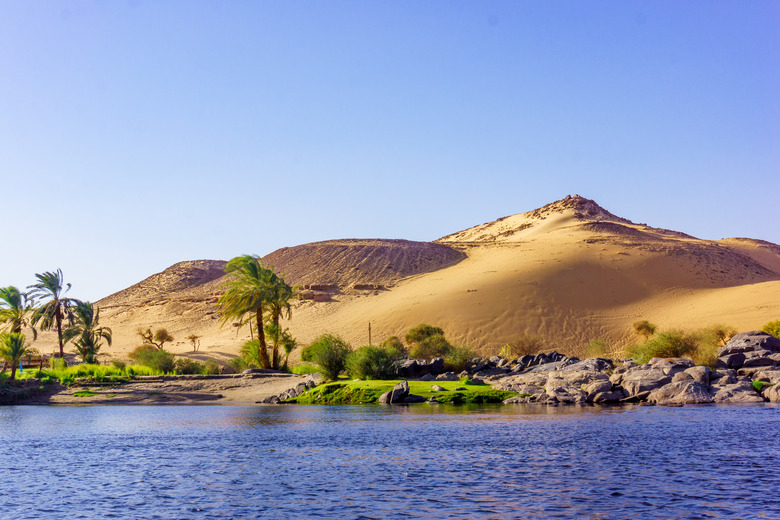What Did Ancient Egyptian Farmers Do While The Nile Flooded?
The River Nile was vital to life in ancient Egypt. Agriculture depended on its summer floods, which fertilized land along the river banks by depositing silt. The population of Egypt grew from nomads who settled along the fertile Nile banks and transformed Egypt into a sedentary, agricultural society by 4795 B.C. Farmers sowed and harvested crops during seasons around the flooding. However, during the inundation, they worked to pay off their taxes.
Two Hydrological Systems
Two Hydrological Systems
The Nile consists of two hydrological systems — the Blue and White Nile rivers, whose confluence is just outside of Khartoum, the capital of Sudan. The White Nile is sourced from Lake Victoria and other Central African lakes, and maintains a regular flow throughout the year. The Blue Nile begins in the Ethiopian mountains at Lake Tana. Its flow is governed by annual monsoon rains carried on winds from the Indian Ocean. These cause a torrential water flow to cascade downstream to the north. It is colored red from the sediment it gathers along its route.
The Agricultural Cycle
The Agricultural Cycle
The ancient Egyptian agricultural cycle was governed by three seasons — the flooding season, called Akhet; the planting season, called Peret; and the drought season, called Shomu. The main flooding began in July and reached its maximum in August. The water started to wane by the end of October and reached its lowest point in May, when the cycle began again. Flood waters could reach heights of 7 meters (23 feet) between May and September.
Measuring the Flood
Measuring the Flood
The Nile has a very predicable flooding season, but the depth of inundation is variable. High floods could devastate settlements, while low floods reduced crops yields and caused famine. Ancient Egyptians developed a method to measure the Nile's flood level, as their harvests and livelihood depended on the river's annual flow. The nilometer was a method that recorded the level of a flood through marks on river banks, along stairs leading to the river, on stone pillars or in water wells. These measurements were used in estimating crop yields and taxes.
Paying Taxes
Paying Taxes
In theory, an Egyptian farmer could rest during the flooding period, as he could neither sow crops nor harvest them. However, Egypt's rulers levied taxes based on the size of a farmer's field and his crop yield. Both during and immediately after flooding, farmers were drafted into forced labor – the corvee – as a method of paying their taxes. They dug and dredged canals that were developed to control the flood waters or to mitigate droughts. They also had to prepare fields for planting. Subsistence farmers – those with only a small area of land who worked land owned by wealthy Egyptians — could only pay off taxes through forced labor during the flood season.
Cite This Article
MLA
Kielmas, Maria. "What Did Ancient Egyptian Farmers Do While The Nile Flooded?" sciencing.com, https://www.sciencing.com/did-ancient-egyptian-farmers-nile-flooded-18466/. 9 March 2018.
APA
Kielmas, Maria. (2018, March 9). What Did Ancient Egyptian Farmers Do While The Nile Flooded?. sciencing.com. Retrieved from https://www.sciencing.com/did-ancient-egyptian-farmers-nile-flooded-18466/
Chicago
Kielmas, Maria. What Did Ancient Egyptian Farmers Do While The Nile Flooded? last modified March 24, 2022. https://www.sciencing.com/did-ancient-egyptian-farmers-nile-flooded-18466/
